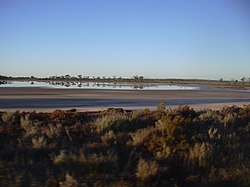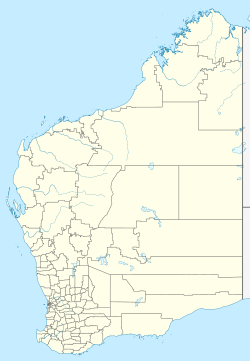Wheatbelt (Western Australia)
 From Wikipedia - Reading time: 14 min
From Wikipedia - Reading time: 14 min




The Wheatbelt is one of nine regions of Western Australia defined as administrative areas for the state's regional development, and a vernacular term for the area converted to agriculture during colonisation.[a] It partially surrounds the Perth metropolitan area, extending north from Perth to the Mid West region, and east to the Goldfields–Esperance region. It is bordered to the south by the South West and Great Southern regions, and to the west by the Indian Ocean, the Perth metropolitan area, and the Peel region. Altogether, it has an area of 154,862 square kilometres (59,793 sq mi) (including islands).
The region has 42 local government authorities, with an estimated population of 75,000 residents. The Wheatbelt accounts for approximately three per cent of Western Australia's population.[3]
Ecosystems
[edit]The area, once a diverse ecosystem, reduced when clearing began in the 1890s with the removal of plant species such as eucalypt woodlands and mallee, is now home to around 11% of Australia's critically endangered plants.[4]
A number of nationally threatened birds reside in the Wheatbelt, including the endangered Carnaby's black cockatoo and the vulnerable malleefowl.[5]
The Wheatbelt encompasses a range of ecosystems and, as a result, there are a range of industries operating in the region.[clarification needed]
In the Interim Biogeographic Regionalisation for Australia there are a number of subdivisions such as the Avon Wheatbelt (AVW), and a further breakdown of Avon Wheatbelt P1 (AW1) and Avon Wheatbelt P2 (AW2), Jarrah Forest, Geraldton Sandplains and Mallee regions.
Industry and economy
[edit]Near the coast, the region receives relatively high rainfall and mild temperatures, and its 150 kilometres (93 mi) of coastline is a significant tourist area. In contrast, the eastern fringe is very arid, and is mainly used for pastoral farming of sheep. Mining of gold, nickel and iron ore also occurs. The remainder of the region is highly suited to agriculture, and is the source of nearly two thirds of the state's wheat production, half of its wool production, and the majority of its lamb and mutton, oranges, honey, cut flowers and a range of other agricultural and pastoral products.
Change
[edit]With a range of climate and economic changes in the region, considerable effort is made by government at all levels to cope with the decline of some communities, and create opportunities for ventures that keep population in the region.[6] Cultural change with population changes in many localities has been identified by local museums and historical societies, including online documentation.[7]
- Bruce Rock
- Corrigin
- Cunderdin
- Dowerin
- Goomalling
- Hyden
- Kellerberrin
- Koorda
- Kulin
- Lake Grace
- Meckering
- Merredin
- Narrembeen
- Newdegate
- Nungarin
- Southern Cross
- Westonia
- Wyalkatchem
- Yelbeni
Also the literary tradition of writers including the wheatbelt in their writing included:[8]
Lesser known writers also have the wheatbelt environment in their writing such as Lilian Wooster Greaves.
Transport
[edit]The Wheatbelt once had an extensive railway system, which transported bulk wheat grain. It has been reduced in part, while the main lines are being supported. Grain is transported on those lines to ports for export from the CBH grain receival points (grain silos), which are primarily located in the Wheatbelt region.
Six main highways radiating out from Perth serve the Wheatbelt: Brand Highway (north-west to Geraldton), Great Northern Highway (north-east to Wyndham), Great Eastern Highway (east to Kalgoorlie), Great Southern Highway (east to York, then south to Cranbrook), Brookton Highway (east-south-east to Brookton), and Albany Highway (south-east to Albany). A network of main roads connects towns within the Wheatbelt to each other, the highways, and neighbouring regions, with local roads providing additional links and access to smaller townsites. Roads are often named after the towns they connect.[9][10][11]
Local government areas
[edit]The following list is the shires listed in the Wheatbelt as designated by the Wheatbelt Development Commission.[12] Some shires in adjoining regions are traditionally considered part of the Wheatbelt – there are shires in the Great Southern, Goldfields-Esperance and Mid West regions that are dominantly grain growing areas.
- Beverley
- Brookton
- Bruce Rock
- Chittering
- Corrigin
- Cuballing
- Cunderdin
- Dandaragan
- Dalwallinu
- Dowerin
- Dumbleyung
- Gingin
- Goomalling
- Kellerberrin
- Kondinin
- Koorda
- Kulin
- Lake Grace
- Merredin
- Moora
- Mount Marshall
- Mukinbudin
- Narembeen
- Narrogin
- Northam
- Nungarin
- Pingelly
- Quairading
- Tammin
- Toodyay
- Trayning
- Victoria Plains
- Wagin
- Wandering
- West Arthur
- Westonia
- Wickepin
- Williams
- Wongan-Ballidu
- Wyalkatchem
- Yilgarn
- York
Sub-regions within the Wheatbelt
[edit]There are numerous subdivisions of the Wheatbelt, and in most cases the separation is by local government areas.
Wheatbelt Development Commission
[edit]The Wheatbelt Development Commission[13] (WDC) breaks the region up into five sub-regions with four offices:
Avon
[edit]Central Coast
[edit]Central Midlands
[edit]Central East
[edit]Wheatbelt South
[edit]Tourism regions
[edit]Most of the Wheatbelt is included in the larger Australia's Golden Outback.[14][15][16]
Due to their proximity to Perth, however, the following shires are instead promoted as part of the Destination Perth region. The tourist precincts are included:[17]
- Avon Valley[18]
- Peel and Rockingham
- Sunset Coast
- Swan Valley
Finally, the northwestern Shire of Dandaragan is promoted as part of Australia's Coral Coast region due to the presence of the larger seaside towns of Cervantes and Jurien Bay, which developed independently of wheat-growing.[19]
Other regional designations
[edit]The Wheatbelt is separated into other designations at various times as well:
See also
[edit]Notes
[edit]References
[edit]- ^ "THE WHEAT BELT". The West Australian. Perth. 13 October 1920. p. 7. Retrieved 11 September 2015 – via National Library of Australia.
- ^ "The New Agricultural Commissioner for Western Australia's Wheat Belt". Bunbury Herald. WA. 27 April 1911. p. 3. Retrieved 11 September 2015 – via National Library of Australia.
- ^ "Government of Western Australia Department of Regional Development" (PDF). Wheatbelt: a region in profile 2014. 2014. Archived from the original (PDF) on 19 October 2016. Retrieved 17 May 2016.
- ^ Silcock, Jen (1 September 2016). "Hanging on: What does it mean to be Red Hot?: Australia's most imperilled plants and their recovery". Wildlife Australia. 53 (3).
- ^ Nationally threatened birds of the Western wheatbelt Australian government, Environment Australia 2000, accessed 7 May 2019
- ^ "Wheatbelt Development Commission". Retrieved 7 April 2024.
- ^ "Museums in the wheatbelt". Retrieved 7 April 2024.
- ^ Hughes-d'Aeth, Tony; ProQuest (Firm) (2017), Like nothing on this earth : [a literary history of the wheatbelt], UWA Publishing, ISBN 978-1-76080-163-2
- ^ Main Roads Western Australia (28 February 2011). "Wheatbelt Network" (PDF) (Map). Intergrated Service Arrangement. 1:2,040,816. Government of Western Australia. Archived from the original (PDF) on 3 August 2013. Retrieved 5 October 2013.
- ^ Main Roads Western Australia (13 August 2013). Wheatbelt North Region map (PDF) (Map). 1:721,154. Version 1.0. Government of Western Australia. Archived (PDF) from the original on 29 August 2013. Retrieved 5 October 2013.
- ^ Main Roads Western Australia (13 August 2013). Wheatbelt South Region map (PDF) (Map). 1:590,551. Version 1.0. Government of Western Australia. Archived (PDF) from the original on 29 August 2013. Retrieved 5 October 2013.
- ^ http://wheatbelt.wa.gov.au/Maps – the most helpful maps being the "Wheatbelt Development Commission Map"
- ^ "Wheatbelt Development Commission". Retrieved 2 October 2013.
- ^ Western Australian Visitor Centre (2020), Western Australia's golden outback self drive guide : Gascoyne & Murchison, Wheatbelt, Esperance & Fitzgerald Coast, Kalgoorlie & Goldfields, Australia's Golden Outback, retrieved 28 October 2020
- ^ "Western Australia's Wheatbelt Holiday Destination | Australia's Golden Outback". Australia's Golden Outback. Retrieved 28 October 2020.
- ^ Western Australian Visitor Centre (2020), Australia's golden outback, Western Australia : holiday planner, Western Australian Visitor Centre, retrieved 10 February 2019
- ^ "Conditions of Membership". Destination Perth. Retrieved 4 September 2022.
- ^ "Avon Valley". Destination Perth. Retrieved 4 September 2022.
- ^ "The Coral Coast Highway". Australia's Coral Coast. Retrieved 4 September 2022.
- ^ True, Denise; Western Australia. Department of Agriculture (1995), North-east wheatbelt remnant vegetation survey. Volume A, Koorda : prepared for WA Department of Agriculture, The Dept, retrieved 11 February 2019
- ^ Wooller, Susan J; Moore, Susan A; Australian Heritage Commission; Western Australian Natural Environment Evaluation Panel (2000), Regional assessment of the wheatbelt of Western Australia : Central Wheatbelt, Murdoch University, ISBN 978-0-86905-746-9
- ^ Promaco Geodraft (2013), The Open Wheatbelt (5th edition, January 2013 ed.), [Mount Hawthorn, Western Australia] Promaco Geodraft, retrieved 11 February 2019
Further reading
[edit]- Hughes-d'Aeth, Tony (2017). Like Nothing on this Earth: A Literary History of the Wheatbelt. Crawley, WA: UWA Publishing. ISBN 9781742589244.
 KSF
KSF

